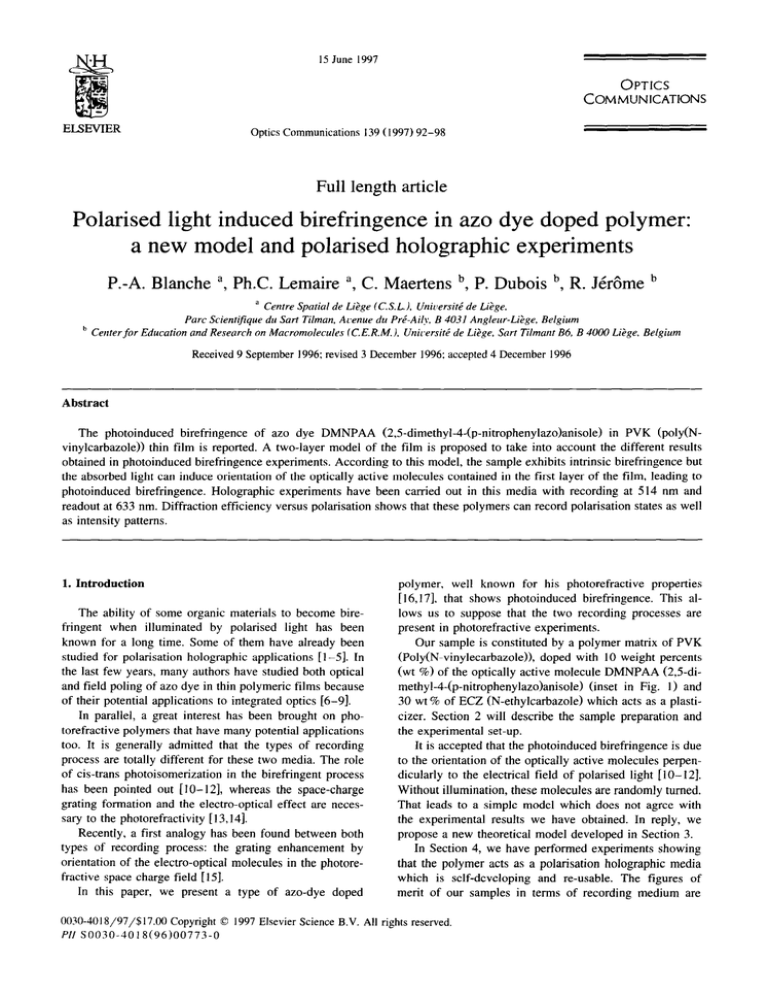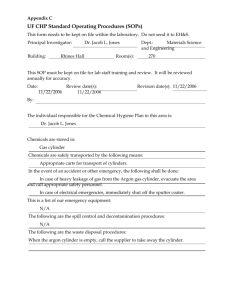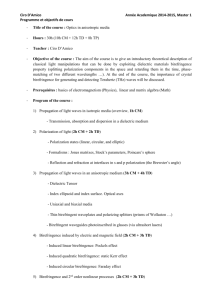
15June
1997
OPTICS
COMMUNICATIONS
ELSEVIER
Optics Communications
139 (1997) 92-98
Full length article
Polarised light induced birefringence in azo dye doped polymer:
a new model and polarised holographic experiments
P.-A. Blanche a, PhC. Lemaire a, C. Maertens b, P. Dubois b, R. J&me
b
’ Centre Spatial de Li2ge (C.S.L.), lJnir;er&? de Li.?ge.
Parr Scientifique du Sart Tilman, Avenue du Pr&Aily. B 4031 Angleur-LGge, Belgium
b Centerfor Education and Research on Macromolecules (C.E.R.M.). Unirersite de LiPge, Sart Tilmant 86, B 4000 Li>ge. Belgium
Received 9 September
1996; revised 3 December
1996: accepted 4 December
1996
Abstract
The photoinduced birefringence
of azo dye DMNPAA (2,5-dimethyl-4-(p-nitrophenylazo)anisole)
in PVK (poly(Nvinylcarbazole)) thin film is reported. A two-layer model of the film is proposed to take into account the different results
obtained in photoinduced birefringence experiments. According to this model, the sample exhibits intrinsic birefringence but
the absorbed light can induce orientation of the optically active molecules contained in the first layer of the film, leading to
photoinduced birefringence. Holographic experiments have been carried out in this media with recording at 514 nm and
readout at 633 nm. Diffraction efficiency versus polarisation shows that these polymers can record polarisation states as well
as intensity patterns.
1. Introduction
The ability of some organic materials to become birefringent when illuminated by polarised light has been
known for a long time. Some of them have already been
studied for polarisation holographic applications [l-5]. In
the last few years, many authors have studied both optical
and field poling of azo dye in thin polymeric films because
of their potential applications to integrated optics [6-91.
In parallel, a great interest has been brought on photorefractive polymers that have many potential applications
too. It is generally admitted that the types of recording
process are totally different for these two media. The role
of cis-trans photoisomerization
in the birefringent process
has been pointed out [IO- 121, whereas the space-charge
grating formation and the electro-optical effect are necessary to the photorefractivity [ 13,141.
Recently, a first analogy has been found between both
types of recording process: the grating enhancement by
orientation of the electro-optical molecules in the photorefractive space charge field [ 151.
In this paper, we present a type of azo-dye doped
polymer, well known for his photorefractive
properties
[ 16,171, that shows photoinduced birefringence. This allows us to suppose that the two recording processes are
present in photorefractive experiments.
Our sample is constituted by a polymer matrix of PVK
(Poly(N-vinylecarbazole)),
doped with IO weight percents
(wt %) of the optically active molecule DMNPAA (2,5-dimethyl-4-(p-nitrophenylazo)anisole)
(inset in Fig. 1) and
30 wt % of ECZ (N-ethylcarbazole)
which acts as a plasticizer. Section 2 will describe the sample preparation and
the experimental set-up.
It is accepted that the photoinduced birefringence is due
to the orientation of the optically active molecules perpendicularly to the electrical field of polarised light [lo-121.
Without illumination, these molecules are randomly turned.
That leads to a simple model which does not agree with
the experimental results we have obtained. In reply, we
propose a new theoretical model developed in Section 3.
In Section 4, we have performed experiments showing
that the polymer acts as a polarisation holographic media
which is self-developing
and re-usable. The figures of
merit of our samples in terms of recording medium are
0030-4018/97/$17.00
Copyright 0 1997 Elsevier Science B.V. All rights reserved.
PI/ SOO30-4018(96)00773-O
93
P.-A. Bkmchr et ul. / Optics Cornttlunictrtions139 (IY97) 92-98
azobis-isobutyronitrile
tions in methanol.
(AIBN), followed by two precipita-
2.2. Samples preparation
450
500
550
600
Wavelength
650
700
750
(nm)
Fig. I, Absorption coefficient spectrum of a 10 wt c/ DMNPAA
doped PVK film with 30 wt 7c of ECZ. The absorption coefficient
of the two wavelengths used for the experiments presented are
indicated. Inset: DMNPAA molecule representation.
quite low but the aim of these experiments was to study
the writing process, not to develop a good recording
medium.
2. Experiments
A 10% in weight blend of DMNPAA in PVK/ECZ
matrix (66/33 wt % respectively) was prepared by dissolving the polymer and the doping molecules in tetrahydrofuran (THF). The solution was filtered through a 0.5
urn filter and solvent was further evaporated under reduced pressure in rotavapor (15 mm Hg). The resulting
polymer was frozen in liquid nitrogen and crushed in fine
powder. Glass temperature CT,), determined by Differential
Scanning Calorimetry (DSC) was found to be around
10°C. This powder is placed on a glass plate between
teflon spacers, and heated at 140°C where the polymer
begins to flow. A second glass plate is deposited above the
other and pressed for 30 minutes to spread out the polymer. This operation provides a film with a good optical
quality: homogeneous phase and coloration and without
bubbles. By this way, we are able to make films with
uniform thickness ranged between 10 and 100 pm depending on the spacer thickness.
The absorption coefficient spectrum of the polymer
film recorded between 470 nm and 750 nm is shown in
Fig. 1, this result is similar to those presented in Ref. [ 171.
2. I. Products
2.3. Natural and photo-induced
2.5dimethylphenol
(purchased in Janssen), potassium
nitrite (Janssen), iodomethane (Aldrich), N-vinylcarbazole
(Fluka). p-nitro aniline (Janssen) were used as received.
N-ethylcarbazole (Janssen) was purified by two successive
recrystallizations from methanol.
2,5-dimethyl-4-(p-nitrophenylazo)
anisole (DMNPAAJ
was synthesised by an azo coupling of 2,5 dimethylphenol
with p-nitroaniline followed by Williamson alkylation with
iodomethane. Overall yield was 90%. Experimental procedures will be described elsewhere.
The structure was confirmed by ‘H nuclear magnetic
resonance and Fourier transform infra-red spectroscopy.
The purity was checked by thin-layer chromatography.
Poly(N-vinylcarbazole)
was synthesised
by radical
polymerisation of N-vinylcarbazole
monomer, initiated by
Spatial filter
birefringence
We have used a 100 p,rn thickness sample. The natural
birefringence
of the polymer film has been brought in
evidence by placing it between crossed polarisers and by
illuminating it by natural light. These experiments have
shown that the natural birefringence axes and the phase
retardation depend on the location on the film. The natural
birefringence is probably a result of the sample preparation
since it appeared, in some samples, a correlation between
the polarisation axes and the spreading of the polymer
during the press process. No means to avoid natural birefringence has been found.
For photo-induced
birefringence
experiments,
two
nearly parallel beams are incident to the sample, as shown
in Fig. 2. The first one, coming from an argon laser
Analyzer
Lens
sample
h/2 plate
514 filter
ector
Mirror
Polarizer
Fig. 2. Geometry of the experimental set-up used for the photoinduced birefringence experiments.
P.-A. Blanche et d/Optics
94
Communications
139 (1997) 92-98
?
0
45
90
135
180
Polarisation
225
270
angle
\y (0)
315
360
Fig. 3. Transmittance of the HeNe beam versus the polarisation angle between the argon and the HeNe beams. The solid line represents the
fit by our two-layer model (Eq. (3)). the parameters are given besides the graph. The dotted curve is the tit by the model taking only into
account the photoinduced birefringence (one-layer model: A = 0). In order to reach the same transmittance at 45”, the parameter r/2 has
been set equal to 4.4.
emitting at a wavelength of 514 nm, is linearly polarised
and a half-wave plate is used to rotate the polarisation axis
into the proper direction. After being filtered and expanded, this beam reaches the sample where it is strongly
absorbed. The second one, a HeNe beam at a wavelength
of 633 nm, is also linearly polarised; it traverses the
sample where it is weakly absorbed and further, crosses an
analyzer rotated at 90” with respect to the incident polarisation. A filter that has an absorption bandwidth centred on
514 nm is placed before the detector in order to stop any
diffuse or direct light coming from the argon laser.
This set-up allows us to perform the following measurements. First, by rotating the half-wave plate on the
path of the argon beam, we have recorded the transmitted
intensity of the HeNe beam versus the angle between the
red (fixed) and green beam polarisations. A typical result
is shown in Fig. 3. Second, we have monitored the transmitted HeNe light in function of the argon intensity arriving on the sample (Fig. 4).
According to the location where the HeNe beam crosses
the sample, the results obtained can change significantly:
the curve of the transmitted HeNe intensity as a function
Poiarisation angle
_
-- ----fB-
0
40a
..............
120”
160°
10
20
Argon
30
intensity
40
50
60
(mW/cm2)
Fig. 4. Transmittance of the HeNe beam versus the intensity of the argon beam for differeat
The lines have no mathematical meaning, they are only guides to the eyes.
angles between the polarisation
of the beams.
95
P.-A. Blanche et al. / Optics Communications I39 (1997) 92-98
of the angle between the argon and the HeNe light polarisation (Fig. 3) presents four maxima with variable amplitudes for a 360” rotation. In order to take these results into
account, we will introduce in the next section a new model
describing the polymer behaviour.
phase retardation
3. Model
A model that takes only the photoinduced birefringence
into account does not explain the results of transmittance
versus the polarisation angle that we have obtained. lndeed. it predicts an equivalent transmission maximum at
45” and 135” whereas it is not the case as seen in Fig. 3.
For this reason we have worked out a new simple two-layer
model to describe the polymer behaviour. A realistic physical model would probably require an infinite number of
layers, each acting as a retardation plate. But, conversely
in liquid crystal media, it is not possible to find a relation
between the angle of the birefringence axes and the position of the layer. Thus the matrix system does not reduce
itself and contains an infinite number of matrices. Moreover, in view of the results obtained by the two-layer
model, it seems not useful to complicate the system by
increasing the number of layers.
In our model, the sample acts as two birefringent
plates. The first one is able to orientate its principal axis on
the direction of the incident argon light polarisation and its
thickness (or its effective phase retardation) depends on
the beam power. This layer absorbs the major part of the
beam; indeed, for a 514 nm beam at 60 mW/cm’
(the
maximum of intensity used in our experiments), we find
only 1 mW/cm’
at 43 Frn depth (at this intensity, effects
are negligible: see Fig. 4). Thus only an insignificant
intensity reaches the second layer. At this location, the
intensity is too weak to generate light induced birefringence. However, the second layer has a natural birefringence and its principal axis, as well as its phase
retardation, depend on the location in the material. The
representation of such a system is shown in Fig. 5.
One can represent the transmission of this optical system, placed in front of an analyzer, by a product of Jones
matrices, giving
E’=
Fig. 5. Equivalent optical system of the polymer film (argon beam
is not shown).
The beam traversing
the system comes from the
HeNe laser. The first birefringent layer has its principal axis
turned in the argon beam polarisation direction, its phase retardation depends on the argon beam intensity. The second birefringent
layer is self-orientated because the argon light does not penetrate
into this layer: it has been absorbed by the first layer.
duced) whose axis is orientated by a I,Gangle with respect
to x and induces a phase retardation of r. The light is
further transmitted through the second birefringent layer
(natural one), whose axis is rotated by an angle cp with
respect to the x axis and has a phase retardation A. At the
end of the optical system, an analyzer, crossed with respect
to x, filters the output polarisation.
The transmitted intensity can be expressed by the development of the matrix equation (1):
I transmitted
=
E’E’
*
=
sin’( r/2)
X (cos’(
sin2(2*)
A/2)
+ sin2( A/2)
X (cos2( r/2)
+ sin’( A/2) cos(2cp))
sin2(2 cp)
+ sin2( r/*)cos(2$))
++(sin(A)sin(T)sin(2$)sin(2cp)
+ sin2( I’/*)
sin2( A/2)
sin(4$)
sin(4cp)).
(3)
For a one-layer model, A = 0 since there is no natural
birefringence.
At this step we have a model with three unknown
parameters (A, r, cp) which can be determined by the fit
of the theoretical function (3) to the experimental measurements of the transmitted intensity in function of the angle
I+!J
(Fig. 3). This latter one is equal to the angle between the
polarisation of the argon beam and the polarisation of the
HeNe beam.
(:, ;)R(-u)(‘-;‘-ei!,2)R(‘p)RW)
(‘1
where the rotation matrices
R(0)
A
=
R(B)
cos( e)
sin( 0 )
-sin(o)
cos(t9)
are defined
as follows:
(2)
Eq. (1) means that the HeNe light, polarised along to
the x axis, crosses the first birefringent layer (photoin-
4. Results and discussion
4.1. Optically
induced molecular orientation
The result of such a fit is presented in Fig. 3 (solid
line). As it can be seen, our model is in good agreement
P.-A. Blanche et al. / Optics Communications
96
E
.iii
E
(d
139 (1997)
92-98
2.4
2
F
8
1.6
,”
n
1.2
T)
8
G
.r
cl
0.8
0.4
z
a’
0
0
10
20
30
40
Argon intensity
50
60
70
(mW/cr??)
(b)
I
I”
0
lo
‘,““),“‘I”“,“‘.,
20
,.,i
30
40
Argon intensity
50
60
70
(mW/cm*)
(cl
_,__.._.....___,
i .._._.__.._._
: ,._._.__...._.
0
T
0
._
0
_ ..__..__...._._
.._..._.____..._._....._.._......
j
20
50
0
10
30
Argon intensity
40
:_
60
70
(m W/cm2)
Fig. 6. The plots obtained by fitting in the photoinduced birefringence experiments versus the argon
parameters: r, A, cp. The figures show the plot of these parameters versus the argon intensity for
according to the HeNe polarisation axis. In the three cases, the curve fit is deduced from our model.
(a) Photoinduced phase retardation r versus argon intensity. (b) Natural phase retardation A versus
natural birefringence versus argon intensity.
polarisation angle, we obtain a triplet of
an argon polarisation angle fixed at 40”
Inset: fit function and parameter values.
argon intensity. (c) Axis angle q of the
P.-A. Blanche et al. /Optics
with the measurement,
contrary to a one-layer model
(dotted line) which predicts the same transmission maximum at 45” and 135”.
Fig. 6 shows the different parameters (A, r, cp) as a
function of the poling beam intensity. These values result
from the above mentioned procedure of fitting (least
squares). The error bars are the standard errors on the
parameters given by the fit program. As expected, the
induced phase retardation r increases with the intensity of
the poling beam. The higher the poling intensity, the
higher the number of molecules that are aligned by the
beam polarisation. We observe also a saturation when all
molecules are aligned. The behaviour of r can be described by the following phenomenological
equation,
r=uef/(l
Communications
97
I39 (1997) 92-W
0
10
20
30
50
60
Fig. 7. Diffraction efficiency versus time on a 100 km thick film.
The argon beams are switched on at t = 0 and one of them is
switched off at r= 35 s. Total argon intensity is 40 mW/cm’.
beam ratio is l/ 1, linear polarisation
+ef),
40
Time (s)
orthogonal
to each other.
(4)
where a is the maximum photoinduced phase retardation,
e the efficiency with which the light induces phase retardation and I the intensity of the argon beam (see Fig. 6a).
Conversely, A. representing the natural birefringence,
is maximum when there is no illumination and decreases
according to the power of the argon beam. Indeed, when
we increase the poling intensity, the photoinduced birefringence stands in for the natural one. The latter decreases
to zero when all the molecules are aligned by the laser, so
A can be expressed by the following equation, where b is
the phase retardation of the sample without illumination
(see Fig. 6h):
write a hologram in such a polarisation configuration
proves that the media can record the polarisation state. In
this kind of experiment, the photorefractive recording process can be dismissed because, by its nature, this process
can only record an intensity grating. The dynamic of
recording and erasing can be seen in Fig. 7. Further
experiments on holographic recording are currently being
done to improve our knowledge on this material.
A=b/(l
5. Conclusions
+rl).
(5)
The last variable, cp. is a constant if the HeNe beam
does not change location in the sample during the experiments (Fig. 6~).
Once again, these models are in relatively good agreement with the measurement.
4.2. Polarisdon
hologruphy
The preceding experiments have proved that the polymer can record the polarisation state of the argon beam.
We have used this property to write polarisation holograms
in the sample. The linearly polarised argon beam is split
into two parts, one polarisation is rotated by 90”, and these
orthogonal polarised beams cross themselves into the sample. In such a situation the beams do not interfere in
intensity, however a similar pattern information is created
by means of the polarisation state which is modulated
consequently to the optical path difference [18]. A nonpolarised HeNe beam is used to read out the hologram at
the Bragg angle.
By using a total recording power of 2 X 20 mW/cm’
(beam ratio I / 1, linear polarisation orthogonal to each
other), we have obtained a diffraction efficiency of the
HeNe beam of about 0.02% and a sensitivity
S,, =
(dn/dw)(l/d)=O.l
(J/cm’)-‘.
The fact that we can
We have shown that a non-linear molecule used in a
photorefractive polymer shows photoinduced birefringence
in response to polarised light. This material can be used as
a polarised recording medium. This supposes that the
electro-optical
and photo-orientation
effects are certainly
acting
in photorefractive
experiments
using
these
molecules.
We have introduced a new model describing the polymer film behaviour in the photoinduced birefringent experiment. This model separates the sample into two layers, the
first one strongly absorbs the polarised argon light inducing an orientation of the molecules in the beam polarisation. This leads to a photoinduced birefringence
whose
phase retardation depends on the beam intensity. The
argon light does not penetrate into the second layer which
only presents natural birefringence affecting the polarisation too.
Using the principle of polarisation holography recording, we have carried out diffraction experiments to prove
the nature of the recording process and for determining the
figure of merit of the polymer film. The maximum diffraction efficiency that could be achieved by writing with
orthogonal polarised beams is 0.02%, and the sensitivity is
S,, = (dq/dw)(l/d)
= 0.1 (J/cm’)-’
depending on the
experimental conditions. We are presently studying new
98
P.-A. Blunche et al./ Optics Communications
side-chain
polymers
in order to improve
merit of the polymer films.
the figures
of
References
[l] T. Todorov, L. Nokolova and N. Tomova, Appl. Optics 23
(1984) 4309.
[2] S. Calixto and R.A. Lessard, Appl. Optics 23 (1984) 4313.
[3] M.S. Ho, A. Natansohn and P. Rochon, Macromolecules
28
(1995) 6124.
[4] E. Mohajerani, E. Whale and G.R. Mitchell. Optics Comm.
92 (1992) 403.
[5] S.V. O’Leary, Optics Comm. 104 (1994) 245.
[6] Z. Sekkat and M. Dumont, Appl. Phys. B 54 (1992) 486.
[7] L. Lasker, T. Fischer, J. Stumpe, S. Kostromin, S. Ivanov, V.
Shibaev and R. Ruhmann, Mol. Cryst. Liq. Cryst. 246 (1994)
347.
139 (1997) 92-98
if4 D.J.O. Orzi and J.O. Tocho, Opt. Eng. 35 (1996) 47.
191 T. Huang and K.H. Wagner, J. Opt. Sot. Am. B 13 (1996).
[lOI G.S. Kumar and D.C. Neckers, Chem. Rev. 89 (1989) 1915.
r111 Z. Sekkat, D. Morichere, M. Dumont, R. Loucif-Saibi and
J.A. Delaire, J. Appl. Phys. 71 (1992) 1543.
26
[121T. Sasaki, T. Ikeda and K. Ichimura, Macromolecules
(19931 151.
r131 L. Yu, W.K. Chan, Z. Peng and A. Gharavi, Act. Chem.
Res. 29 (1996) 13.
[I41 H.J. Bolink, V.V. Krasnikov, G.G. Mall&as and G. Hadziioannou, Advanced Materials 6 (1994).
[151 W.E. Moemer, S.M. Silence, F. Hache and G.C. Bjorklund,
J. Opt. Sot. Am. B 11 (19941.
[161B. Kippelen, N. Peyghambarian, S.R. Lyon, A.B. Padias and
H.K. Hall Jr, Electron. Lett. 29 (1993).
[171 B.L. Volodin, Sandalphon, K. Meerholz, B. Kippelen, N.V.
Kukhtarev and N. Peyghambarian,
Opt. Eng. 34 (1995) 2213.
iI81 T. Huang and K.H. Wagner, J. Opt. Sot. Am. B 13 (1996)
282.







